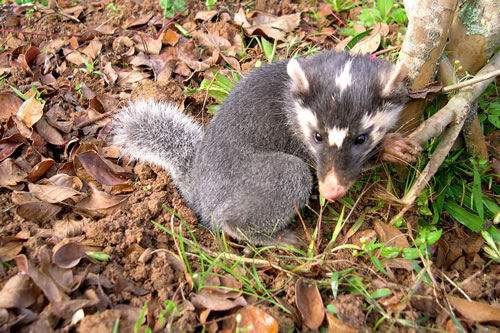Melogale orientalis
IUCN
LCBasic Information
Scientific classification
- name:Melogale orientalis
- Scientific Name:Melogale orientalis,Javan ferret badger,Burmese ferret badger
- Outline:Carnivora
- Family:Suborder Mustelidae Subfamily Genus
Vital signs
- length:39-41cm
- Weight:1-1.5kg
- lifetime:About 10 years
Feature
Able to climb trees, not good at jumping
Distribution and Habitat
Distributed in southern and central China, Taiwan, northern Myanmar, northern India and northern Indochina. Lives in forests, fields, bushes and dense grasslands. Can use arable land with cover and can live near human settlements.
Appearance
The body shape and fur color of the Burmese badger are similar to those of the ferret badger, but it is larger. The needle hairs on the back of the body do not have white hair tips. There is an isolated light brown spot in front of the ear and under the eye, and the white vertical stripes only extend from the top of the head to the back of the neck. The tail hair is coarse and fluffy, and the tail tip is broom-shaped.
Details
The Javan ferret badger's scientific name is Melogale orientalis, and its foreign name is Javan ferret badger. It is an animal of the genus Ferret badger.

The Javan ferret badger inhabits forests, shrubs, and trees. It lives in self-excavated tree holes or rock caves. It only goes out to hunt in the dusk or night, and rests in caves during the day. The range of activities ranges from the flat ground to the foothills of the mountains. It has strong climbing ability, but it does not often climb into trees. It moves very slowly. It is like being dragged on the ground and cannot jump.
The main food of the Javan ferret badger is invertebrates in the soil, especially earthworms and insects, fruits and seeds. Secondary food consists of small amounts of small mammals, reptile carrion and eggs. There were no reports of poultry predation. Forages almost entirely at night. They forage alone, but their nest areas overlap significantly, and a hermaphrodite group consisting of up to four members uses a common cave, indicating the existence of a certain social structure, and it is likely to establish a group nest area like dogs and badgers. There is no difference in the nest area between males and females, with an average of 1.3 square kilometers (the range is 0.51 to 4.7 square kilometers).
The Javan ferret badger mainly detects prey through its sense of smell, but it still has good hearing and touch. It has taste glands. When frightened or forced, it will secrete a foul odor, and the yellow and white spots on its head and throat serve as warning colors.
It has been included in the China Biodiversity Red List - Vertebrate Volume, and the assessment level is Endangered (EN).
Protect wild animals and eliminate wild game.
Maintaining ecological balance is everyone’s responsibility!








